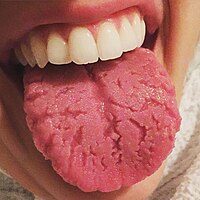Geographic And Fissured Tongue

Clinical Features
Turpin and Caratzali (1936) concluded that the same gene is responsible for both geographic tongue and fissured tongue. Dawson and Pielou (1967) observed 18 persons with geographic tongue, some of whom also had fissured tongue, in 3 generations with probable autosomal dominant pattern. Under the designation 'scrotal tongue,' Tobias (1945) reported 2 families, one with 2 generations and the other with 4 generations affected. Geographic tongue was an associated feature in the proband of 1 family. Seiler (1936) assembled the most extensive pedigree data supporting autosomal dominant inheritance. Kullaa-Mikkonen (1988) studied the genetics of fissured tongue in 31 families. An in vivo method of stereomicroscopy was used for examining the dorsum of the tongue. It was concluded that fissured tongue with smooth-surfaced papillae is transmitted as a dominant with incomplete penetrance and is preceded by geographic tongue. The severity of fissured tongue increases with age. Tongue fissuring with normal-appearing filiform papillae was found not to be familial and was not associated with geographic tongue. In the view of Kullaa-Mikkonen (1988), fissuring with normal papillary structure should be considered a variation of normal anatomy, whereas fissured and geographic tongue is a clinical and etiologic disease entity. The tongue is furrowed and grooved in about 5% of the normal population (Gorlin, 1982).